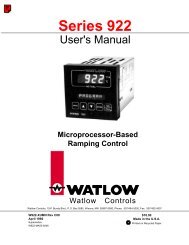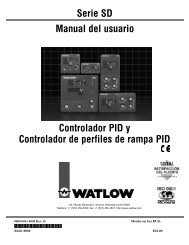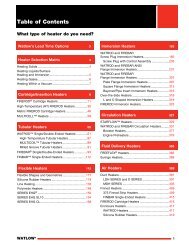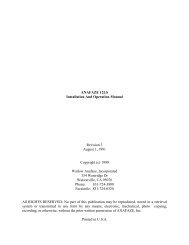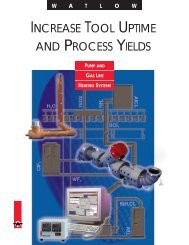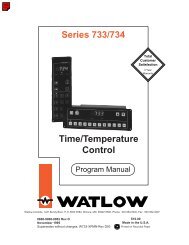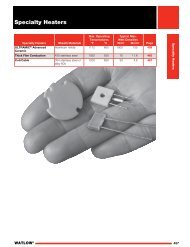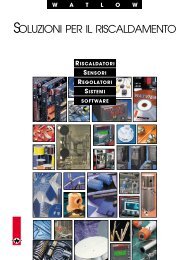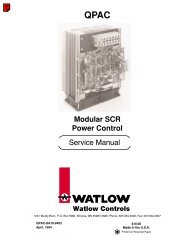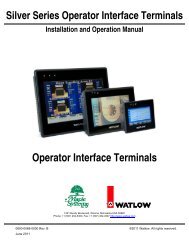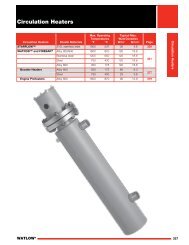Series 808 Retrofit Guide - Watlow
Series 808 Retrofit Guide - Watlow
Series 808 Retrofit Guide - Watlow
Create successful ePaper yourself
Turn your PDF publications into a flip-book with our unique Google optimized e-Paper software.
Using This <strong>Retrofit</strong> <strong>Guide</strong><br />
This document is best viewed with Adobe Reader 9.0. To obtain the latest version of Adobe Reader, visit<br />
http://www.adobe.com<br />
Specification sheets on <strong>Watlow</strong> ® product may be obtained at http://www.watlow.com/literature/specsheets.cfm<br />
User Manuals on <strong>Watlow</strong> product may be obtained at http://www.watlow.com/literature/manuals.cfm<br />
Additional information on other <strong>Watlow</strong> products may be obtained by visiting http://www.watlow.com/<br />
To locate a controller open the file <strong>Series</strong> <strong>808</strong> Source.pdf at bottom of this document, then search on the part number<br />
such as <strong>808</strong>E-0120-0000. Press the Ctrl+F to highlight search box. Enter partial or complete model number. Hit enter<br />
key to search document. Use the Help feature in Adobe Reader on how to search documents.<br />
Some retrofit choices do not have all of the features or inputs/output types of the original. Notes are added to bring<br />
attention to differences.<br />
If you do not find your model number, contact <strong>Watlow</strong> Technical Support. For custom models contact the OEM<br />
(Original Equipment Manufacturer) for possible replacement.<br />
If there are multiple listings, then the retrofit is conditional upon field use. Select the appropriate selection. The<br />
Specification Sheets are included at the bottom of this document when available.<br />
Before selecting a replacement controller:<br />
1. Know the application.<br />
Temperature range<br />
Sensor type<br />
Is the sensor upgradeable if required<br />
Additional input requirements – remote set points, secondary sensor or events<br />
Output required – control, alarm, event<br />
Is the power-switching device upgradeable<br />
Operating voltage of controller<br />
Mounting requirements – panel space<br />
Is a safety limit device required<br />
2. Know the product.<br />
Inputs – quantity and type<br />
Control function – direct (cool) or reverse (heat)<br />
Alarms – quantity and type<br />
Outputs – switched DC, SSR, or mechanical relay<br />
Communication requirements (configuration, operations, and device type connected)<br />
Which control features are required (cascade, ratio, slidewire, differential, remote control, profiling, other)<br />
3. Use your best judgment for selecting a replacement controller. All applications require close examination of inputs,<br />
outputs and the control mode to have the controller function properly.<br />
4. Safety: Remember to make sure all redundant safety equipment is in place and working when retrofitting equipment.<br />
If a system has been retrofitted without the proper safety equipment, you could be liable if an accident occurs.<br />
This is only a guide to replacement controllers. If you have doubts, please call (507) 494-5656<br />
and ask for technical support or email wintechsupport@watlow.com. We are here to help. The<br />
suggested replacement will differ in fit and form. Please review the replacement controller<br />
specifications for suitability. Carefully check the notes for additional information that may<br />
apply.
Abbreviation & Terminology (as used in this document)<br />
0.5 – 0.5 amperes of current switching capability<br />
2A – 2 amperes of current switching capability<br />
5A - 5 amperes of current switching capability<br />
10A – 10 amperes of current switching capability<br />
15A – 15 amperes of current switching capability<br />
12-24 – Supply voltage can be between 12 to 24 Volts<br />
100-240 – Supply voltage can be between 100 to 240 Volts<br />
100 ohm DIN – refers to 100-ohm platinum RTD that has a DIN curve.<br />
100 ohm JIS – refers to 100-ohm platinum RTD that has a JIS curve.<br />
1000 ohm DIN – refers to 1000-ohm platinum RTD that has a DIN curve.<br />
1/32 DIN – Deutsche Industrial Norm standard for panel mounted controller, panel size cutout is 1.78”w x 0.88”h.<br />
1/16 DIN – Deutsche Industrial Norm standard for panel mounted controller, panel size cutout is 1.78”w x 1.77”h.<br />
1/8V DIN – Deutsche Industrial Norm standard for panel mounted controller, panel size cutout is 1.78”w x 3.63”h.<br />
1/8H DIN – Deutsche Industrial Norm standard for panel mounted controller, panel size cutout is 3.63”w x 1.77”h”<br />
1/8S DIN – Deutsche Industrial Norm standard for panel mounted controller, panel size cutout is 2.68”w x 2.68”h.<br />
¼ DIN – Deutsche Industrial Norm standard for panel mounted controller, panel size cutout is 3.63”w x 3.63”h.<br />
Action – determines the direction of control. Heat (reverse acting) or Cool (direct acting).<br />
Auto Reset – the limit will automatically reset on a power cycle but requires manual reset on limit trip.<br />
Cascade – a control algorithm in which the output of one control loop provides a set point for another loop. The second<br />
loop, in turn, determines the control action. Cascade control can handle a difficult process with minimal overshoot, while<br />
reaching the set point quickly. This minimizes damage to system components and allows for oversizing heaters for<br />
optimal heat-up rates.<br />
Ch – Channel refers to an analog input. There are single and dual channel controllers.<br />
Control Mode – the method that a controller uses to switch the outputs such as PID, ON/OFF, and Manual.<br />
Differential – control algorithm in which the output is based on the difference of the inputs plus set point.<br />
Dual PID – a controller offering two sets of PID constants. This second set of PID parameters enables the controller to<br />
switch between two sets of PIDs, to compensate for changes in the system characteristics.<br />
DIN – Deutsche Industrial Norm, a set of technical, scientific and dimensional standards developed in Germany. RTD<br />
sensors with the DIN curve change resistance at a rate of 0.00385 ohms/ohms/C.<br />
DIN Rail – standard DIN EN50022 mounting method for attaching devices onto a metal rail.<br />
EZ-ZONE ® – a family of controller products manufactured and sold by <strong>Watlow</strong> Electric Mfg Co
EZ-ZONE ® PM Express – The next generation of controllers leveraging the strong legacy of <strong>Watlow</strong>’s SERIES_93,<br />
SERIES_935 and SERIES_SD controllers where easy-to-use features are needed for basic applications. Available as a<br />
PID controller or Limit controller.<br />
EZ-ZONE ® PM – A panel mount controller from <strong>Watlow</strong> ® offers control options to reduce system complexity and the<br />
cost of thermal loop ownership which is available in common DIN sizes as PID controller, Limit controller and<br />
Integrated controller.<br />
Fixed – refers to a set point that is fixed at one value.<br />
High Limit - device will deactivate output on a temperature rise above set point.<br />
Inductive Load – any device that has a wire winding such as solenoids, electromechanical relays or transformers.<br />
Input – refers to the sensor types that may be connected.<br />
Integral – the set point in integral (on board) to the controller.<br />
JIS – Joint Industrial Standards, a set of technical, scientific and dimensional standards developed in Japan. RTD sensors<br />
with the JIS curve change resistance at a rate of 0.00396 ohms/ohms/C.<br />
Line Voltage – the voltage required powering the electronics of the controller.<br />
Low Limit - device will deactivate output on a temperature drop below set point.<br />
On/Off – a method of control that turns the output full on until set point is reached and then off until the process error<br />
exceeds the hysteresis.<br />
Open Brd – the form factor of this controller is an open circuit board mounted on four standoffs.<br />
Manual Reset – the limit must be reset on a power cycle and requires manual reset on limit trip.<br />
Multi RSP – multiple remote set potentiometers were supported. Each allowed the set point to be selected and adjusted.<br />
NO-ARC Relay – refers to a hybrid electromechanical relay used to drive AC resistive heaters with very long life<br />
(typically greater than 2 million operations)<br />
Relay – refers to an electromechanical relay.<br />
Remote – set point is adjusted using a remote potentiometer.<br />
Panel – the form factor of this controller is mounted through a hole cut in the panel.<br />
PI – Proportional and Integral, a control algorithm mode with two functions: proportional action dampens the systems<br />
response, and integral corrects for droop.<br />
PID – Proportional, Integral, and Derivative, a control algorithm mode with three functions: proportional action dampens<br />
the systems response, integral corrects for droop, and derivative prevents overshoot and undershoot.<br />
Potted – the circuit board and electronics are encased in epoxy.<br />
Proc – Process analog input may accept 0-5, 1-5, 0-10 volts or 0-20 and 4-20 mA.<br />
Profiling – Controller will perform a sequence of programmed steps.<br />
Programmable – The feature is changeable in the field through jumpers and/or parameter selection.
RTD – Resistance Temperature Detector, a sensor that is 100 ohms at 0 degrees C and made of platinum material.<br />
Ratio – a control algorithm in which two analog inputs are required to monitor the process and at least one output adjusts<br />
the controlled part of the process. This feature allows the control of one process as a ratio of another process. This is<br />
especially useful in applications that mix two materials, whether steam, paint or food ingredients.<br />
SSR – Solid State Relay, these devices will switch AC voltage only and require a load to latch on.<br />
Sw DC – Switched DC, a time proportioning DC output used to drive DC input solid state relays.<br />
t/c – Thermocouple sensor device made by joining two dissimilar metals whose standards is identified by a letter.<br />
Temp Range – the range over which the controller could have the set point adjustment.<br />
Thermistor – a sensor that changes resistance as the temperature changes providing very accurate temperature<br />
measurement in a narrow temperature range. Resistance decreases as temperature increases. Similar but not the same as<br />
an RTD.<br />
Universal – an analog input which can be a thermocouple, 100 or 1000 ohm DIN RTD, 1000 ohm potentiometer or<br />
process (volts or milliamperes). Does not include thermistor input selection.<br />
VAC – Volts Alternating Current<br />
VAC/DC- Volts Alternating Current or Direct Current<br />
VDC – Volts Direct Current<br />
VTB Sw DC – Variable Time Base Switched Direct Current, a time proportioning DC output where the cycle time is<br />
variable.



